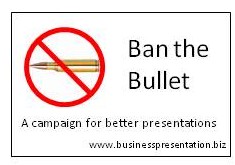Around the world, in every office, conference room and meeting room, every minute, of every day people are standing up giving presentations with a list of bullet points displayed on the screen behind them. Now just because millions of people do it does it make it right? The short answer is NO !
Using bullet points in your presentations is:
- Lazy
- Ineffective
- Futile
They rarely help the overall communications process which the presentation is trying to achieve.
While it is true that the human memory is better at retaining visual information rather than aural information, using bullet points distracts the listener from what the presenter is saying while they read the bullets. Then when the presenter repeats what the audience has just read, it is old news. And we all know how boring it is to hear old news repeated!
If, in an attempt to be more interesting, the presenter rephrases the bullet points in his oration this just ends up confusing the audience as they hear one thing but see something different.
So using bullet points in your presentation is a “lose-lose” situation.
Why do so many people use bullet points? I believe they are a bi-product of the presentation’s development. When you are developing your thoughts for a presentation is very useful to write down short bullet points and to be able to re-order, add and delete points as you think through your presentation. The result being a sheet or sheets of paper covered with a long list of bullet points. The problem comes when people transcribe these bullets into the presentation software.
This usually happens for one of to reasons:
A) The presenter doesn’t know any better.
B) The presenter feels that he/she needs the reminders to help them present the information and keep the presentation on track.
In the latter case, I would suggest that the bullet points are transcribed on to the speaker’s notes, not the slides. That way the speaker can be reminded of what to say, without broadcasting it in advance to his audience.
Using the slides to remind you what to say turns the whole process of giving a presentation on its head. Rather than the presenter leading the presentation with the visual aids supporting what he says, it makes the slides lead the presentation with the presenter demoted to the role of describing what the slides say. In the worst cases the presenter becomes completely redundant as the audience can read the slides and understand the points themselves. The “presenter” would have been better off sending everyone an email, far more efficient.
Hopefully, I have now convinced you that bullet points are not good for your presentations. This raises the next question; what else should you put on our visual aids, or should we do away with the slides altogether?
Personally, I believe slides can help get your message across and help to make it more memorable. After all it was Confucius who once said, “I hear I forget, I see I remember”. What should go on the slides though? Well the clue is in the name, “visual aids”. Your slides should conjure up strong mental images which reinforce what you are saying.
The best example of this I have come across was in a presentation about global warming. The speaker was making the point that what happens in relation to global warming is all down us as individuals. To illustrate the point that one person can make a difference he put up a slide with three images: “American policemen beating up a black person”,”Martin Luther King” and “President Barack Obama”, what a change in one generation!
So I appeal to your better judgement, Ban the Bullets, be more creative and make your presentations work.
If you agree with me the bullet points should be banned from professional presentations, please add you name in the comments box below or take my poll



 Posted by Graham Young
Posted by Graham Young